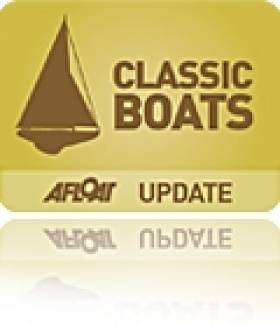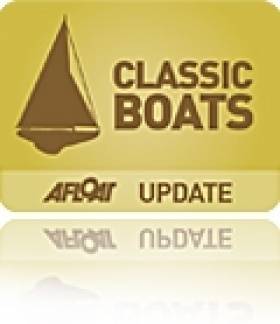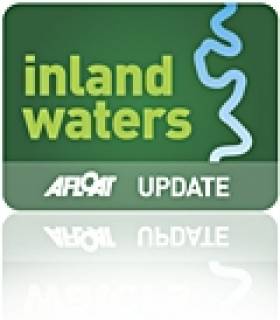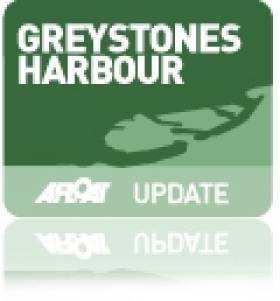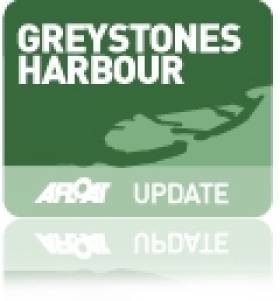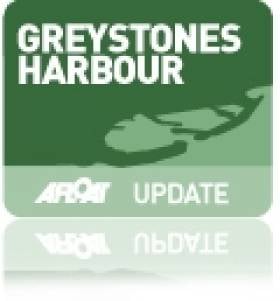Displaying items by tag: NAMA
Progress Underway on Securing Naomh Eanna's Future
#NaomhEanna - Naomh Éanna a former CIE Aran Islands ferry due to be scrapped earlier this year as previously reported, has been acquired by the Irish Ship & Barge Fabrication Company, effectively securing the heritage vessel, writes Jehan Ashmore.
There are plans by IS&BF for a major refit of the veteran vessel that would see her become a tourist attraction back in her former homeport of Galway, as she would feature a boutique hostel, restaurant, cafe and museum in the harbour's single Dun Aengus Dock.
Naomh Eanna is a riveted hulled ship completed in 1958 at the Liffey Dockyard, she carried some 300 passengers and freight including livestock between Galway and the three Aran Islands. She has been lying derelict in Dublin Port for more than 25 years.
She is one of the last such ships built in Europe using rivetted construction technique. In addition she is one of the last ships to be built in the capital and is one of the oldest surviving Irish built ships remaining in our waters.
According to the Naomh Éanna Save Our Ship Campaign, there are negotiations with NAMA over a lease of the graving dock site in Dublin's Grand Canal Basin. This would allow surveyors to access the ship (currently in the graving dock) and determine her hull condition and machinery which is understood to be in working order.
Subject to the outcome of her survey, IS&BF intend to carry out the major refit of the 483 tonnes vessel with her new owners seeking investment from venture capitalists to invest in the project.
Since her shift of berth within Grand Canal Basin earlier this year, there has been an ongoing dispute by campaigners to save Naomh Eanna from scrapping by Waterways Ireland, the Department of Arts, Heritage and the Gaeltacht and NAMA.
Prior to Naomh Éanna's relocation earlier this year, she had been laid-up at her long-term berth alongside Charlotte Quay within the Grand Canal Dock since 1989.
The previous year she had been withdrawn from the west of Ireland service as she failed an inclination test and sailed to Dublin Port. She initially berthed in the capital close to the shipyard from where she was launched into Alexandra Basin.
#NaomhEanna -The Naomh Éanna, a former CIE ferry that campaigners are attempting to save from being scrapped appears to be making progress, reports TheJournal.ie
Having reached a deal to take over responsibility for the vessel with a number of other stakeholders or potential stakeholders involved in deciding her fate.
Only the question of whether NAMA will allow the group to carry out survey and repairs as previously reported on Afloat.ie on the heritage vessel remains a potential stumbling block.
However, a meeting with the agency is being arranged for the coming days, at which the issue will be discussed.
Built in the Liffey Dock in 1956 and once used to carry passengers and supplies between Galway and the Aran Islands, the ferry has been berthed in Dublin's Grand Canal Dock since the late 1980s — where she has since fallen into disrepair.
Waterways Ireland, which manages the docks, had been planning to scrap the vessel; safety concerns were raised in a hull inspection, and the ship could not be moved from the waterway under her own power.
Campaigners had asked for the plan to scrap the vessel to be delayed — but such a move seemed unlikely, until Minister Jimmy Deenihan announced a last-minute stay of execution earlier this year, following questioning in the Seanad from Senator David Norris.
For more on this latest development, visit HERE.
Denis O'Brien Buys Former BJ Marine 'Docklands' Warehouses for €1m
#QUAYCAPITAL - Businessman Denis O'Brien has spent about €1 million on the purchase of two campshire warehouses, fronting the south quays of the Liffey in Dublin's Docklands quarter.
The campshires are the stretches of land between the quay and road on both the north and south quays in Dublin, which in times past, were thronged with warehouses during the days when cargoships used to sail this far up the Liffey.
Mr O'Brien is expected to spend almost as much again on the upgrading and refurbishment work before renting the buildings as restaurants or for other retail uses.
The detached buildings at Sir John Rogerson's Quay date from the 1880s and were handed over to Nama after the Government decided to dissolve the disgraced Dublin Docklands Development Authority.
Selling agent CBRE said most of the considerable number of inquiries it received about the former BJ Marine warehouses came from the catering industry because of their unique quayside location in an area where a large number of professional workers are employed.
"There is obviously a growing demand for services in what has now become a vibrant business district," says Niamh Sheehan, who handled the sales. For more on this story, the Irish Times has a report.
Future of Graving Docks in Limbo as Plot 8 is Transferred to NAMA
#INLAND WATERWAYS - The site of the former graving docks at Grand Canal Dock has been transferred to NAMA in a deal which frees the Dublin Docklands Development Authority (DDDA) from a €29 million plus bank guarantee.
Plot 8 at Sir John Rogerson's Quay is one of a suite of nine sites that have been transferred to the Government's 'bad bank' in a negotiated loan settlement that extricates the Docklands body from loan guarantees given by banks that financed the "disastrous" Dublin Glass Bottle site deal in 2006.
Sites handed over in the deal include the former 'U2 Tower' and the historic BJ Marine premises on the banks of the Liffey, as well as the aforementioned Dublin Glass Bottle site.
The Dublin branch of the Inland Waterways Association of Ireland (IWAI) had been hoping to embark on a restoration of the graving docks at Plot 8 to their former working order (a detailed history of the docks and restoration plans is available HERE).
This project had been given the blessing of the DDDA and Waterways Ireland, which owns the freehold lease on the site, with a view to its restoration helping to fund the Ulster Canal scheme.
However with the transfer of the DDDA's interest in the site to NAMA, the authority has now withdrawn permission for the IWAI to do any restoration work, leaving the future of the graving docks in limbo.
Howth Development Site Not Going Up for Sale
The former Techrete site at Howth Harbour, bought at the peak of the property boom by the crisis-hit Glenkerrin Group, will not return to the market any time soon for fears of only making a fraction of the original cost.
The Irish Times reports that Glenkerrin Group's extensive property portfolio is now under day-to-day management by receivers at Grant Thornton, which is devising an asset management plan with NAMA and estate agents Hooke & MacDonald.
However the 6.5-acre former concrete factory, purchased in 2007 for a total of €62 million, will not be one of those sites put back on the market, as it is expected to only make €10 million today.
Architect Duignan Dooley is currently awaiting planning permission for a development of 250 apartments with a mixture of shopping, offices, leisure and a community centre for the site, adjacent to Howth village.
But there is no indication of when construction might start on the scheme should it be given the go ahead.
NAMA Reviews Further Development of Greystones Harbour
The National Asset Management Agency (NAMA) is currently reviewing plans to continue development of Greystones Harbour, WicklowNews.net reports.
NAMA, which took over the loans connected to the controversial €300 million development, has received Sispar's business plan for developing the proposed public walkway and retail units, as well as amenities for water users, further to proposals outlined in June.
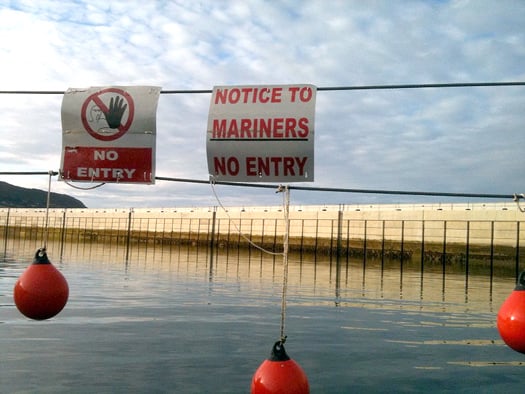
Signs and buoys strung across Greystones harbour to keep mariners out of the new basin
It is expected that the limited development could be completed by September next year, pending NAMA approval. The agency is set to announce its decision next month.
WicklowNews.net has more on the story HERE.
Greystones Harbour Hoardings Could Soon Come Down
The partially redeveloped Greystones Harbour could be opened to the public by mid-summer, The Irish Times reports.
Hoardings may come down to open the marine sections of the €300 million development while plans are finalised to complete the rest of the project - which includes new harbour marina facilities, commercial units, homes and recreational spaces.
A spokesperson for development consortium Sispar said the decision on finding the next phase rests with that National Assets Management Agency (Nama).
Wicklow County Council chairman Tom Fortune said he was hopeful that the hoardings around the harbour area would come down later this year “in part at least”.
The Irish Times has more on the story HERE.
Greystones Harbour Facilities to be Complete by End 2011
Tuesday nights Greystones Town Council meeting was informed by Greystones harbour developer Sispar that the major work on the seawalls would be complete at the end of November 2010.
Following this, construction of the Health Centre, public square and Community buildings for the Sea Scouts, Rowers, Anglers, Divers and Sailors will start in January and should be complete in December 2011.
The hoardings which have blocked the view of the harbour and proposed marina will be taken down as these works are completed in 2011.
Local councillor Derek Mitchell (and a Ruffian keelboat champion) told Afloat.ie: "I welcome this as Greystones had been trying to get the harbour rebuilt for over a hundred years and this will create the best Community Harbour in Ireland".
Councillor Mitchell adds "The developer has applied to change some of the housing and add 34 houses to the North. Wicklow County Council is to vote on this in December. These houses may not be built yet, depending on the housing market, but access will be provided across the site to the North Beach and the new swimming beach there"
"The meeting was also told that the loan would be going in to NAMA, as all loans will, however this is not expected to make any difference to the project", he added.
Councillors asked for more Community tours so that people could see what has been achieved.


























